Melanie van Zyl packs a family into a 4×4 camper for a 3000-kilometre trip to see the best of Botswana in 10 adventure-charged days – all for less than R9500 per person.
Also read: how to book campsites at Botswana’s national parks
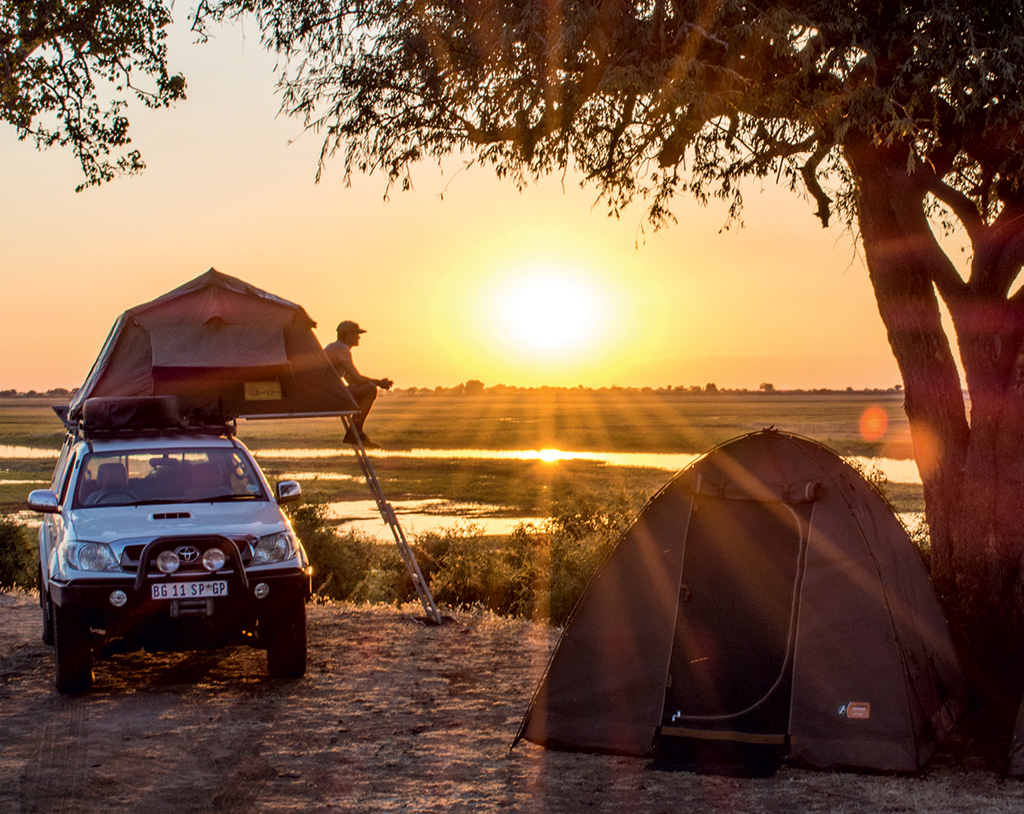
Watch the sun disappear into the Chobe River from the riverfront campsites at Ihaha.
‘What was that?’
Sitting around the fire in Savuti, braaibroodjies crisping in front of us and boerewors spitting beside them, we hear branches rustling in the blackness. Ears prick and only the flames dare move. ‘I think it’s behind you.’
Those words top the list of ‘things
you do not want to hear when camping in the unfenced wilderness of the Savuti marsh’. Famed for an abundance of feline predators, Savuti has just
14 campsites and we’d been warned about nocturnal visitors, to the extent that it’s forbidden to walk to the loos.
‘It sounds like a bushbaby landed in
a tree,’ I whisper. Bryan leaps out of his chair and shines a beam into the bushes. The coal-dark night lifts, revealing
an elephant nonchalantly grazing metres from our dinner. ‘That’s definitely the biggest bushbaby I’ve ever seen.’
It’s the end of day six of what we dubbed the Botswana Blitz, by far the longest we’ve spent in the car. We’d driven from Third Bridge in Moremi, lingering along the green papyrus fringes of the Okavango Delta for most of the morning. In one day we’d had lion near enough to lick our tyres in pink morning light, strained our eyes looking in every mopane tree for leopard, crossed a broken log bridge, been stuck in soupy Savuti sand, gasped in awe at pans of elephants, and drank in a sunset that flooded the zebra-packed plains in cocktail colours better than any Instagram filter.
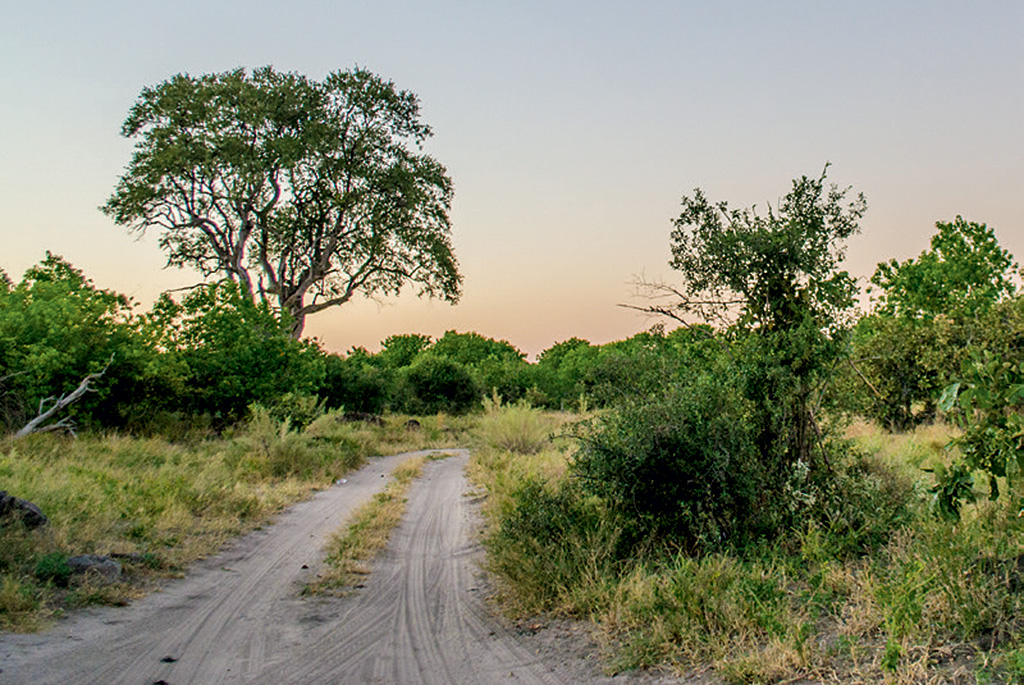
Savuti sand roads.
Self-drive travel through Botswana is an adventure, not a leisure holiday. In
10 days we churned up dust crossing the Makgadikgadi pans, dodged donkeys on the tar road in Maun, crossed rivers in Moremi, bumped along deep mud-dried ruts next to the Savuti marsh and slipped in sand on the tracks leading to Chobe. Seeing the best of Botswana requires
a 4×4 and a sense of humour (I’ll admit,
I lost mine for a bit in the Savuti sand). Here, nature takes centre stage
and you’ll want a front-row seat.
When it comes to tourism, Botswana champions quality over quantity. Destinations are generally pricier than many in South Africa, in order to protect resources, and lodges target wealthy foreign visitors. However, this is a good thing. It means visitor numbers are less, South Africans get special (read cheaper) reserve rates – and it forces us to camp.
The family I introduced to Botswana does not regularly camp but they readily embraced it as part of the thrill. Granted, living on the road and packing up camp each morning – often from 5am – can
be a hack, but it’s the means to magic memories that’ll last a lifetime. We dodged hyena on the way to the loo
and hippo popped in for a visit at Third Bridge. We stirred our coffee to lion roars in the morning, an egg-and-bacon skottel breakfast sizzling on the crusty salt pans.
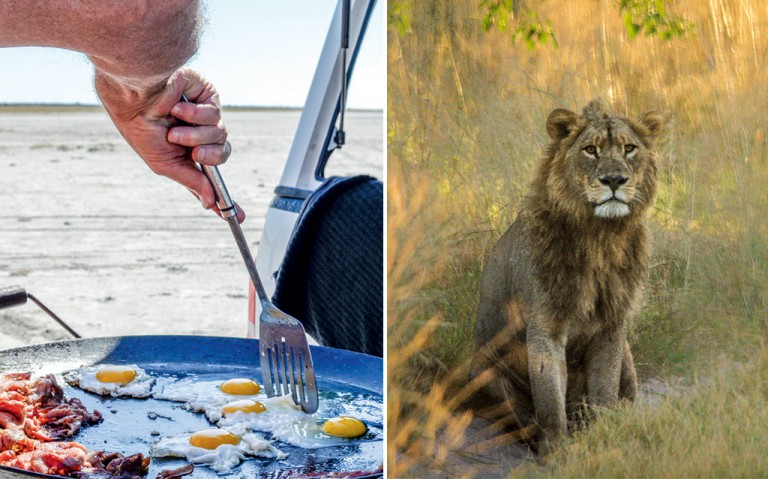
Bacon and eggs taste better on the salt pans; we spotted this young lion near our camp in Third Bridge.
On Kubu Island, we spread out blankets to watch stars splash the night sky; at Ihaha, we spotted a snuffling honey badger; at Chobe we shooed
a warthog away from our lunch. And on that evening in Savuti, when the noises of nature made us freeze, we discovered that new, enormous species of bushbaby.
Camping also means you can splurge the money you save on cool stuff – such as spotting elephant, giraffe and lechwe from a flight over the world’s largest inland delta, or on a mokoro trip and
feel your adrenaline surge as hippos approach your dug-out while piloting through the narrow river channels. Other options are motoring along the Chobe River in a private boat with a guide who knows where to find Jesus birds (African jacanas) and pied kingfisher, or sipping
a sundowner overlooking Botswana’s ‘sea’, the vast Sua Pan, dotted with flamingoes and rowdy pelicans.
In photographs: flying over the Okavango Delta
It’s the kind of adventure that gets under your skin and gives you an unshakeable urge to pack up the car and do it all over again. Needless to say, there’s talk of a Namibia trip next.

Watching the sun rise over the Sua Pan from Kubu Island is magic epitomised.
Best of Botswana itinerary
Day 1 – 620km
You can buy groceries for the next two days at the Spar in Serowe. Camp at Khama Rhino Sanctuary ‒ it’s good value and eases you into the Botswana mood. Park fees and camping costs about R210 per person per night. Otherwise, Kwa Nokeng is another easy stopover on the way from Gauteng. It close to Martin’s Drift Border and you can camp for just R110 per person.
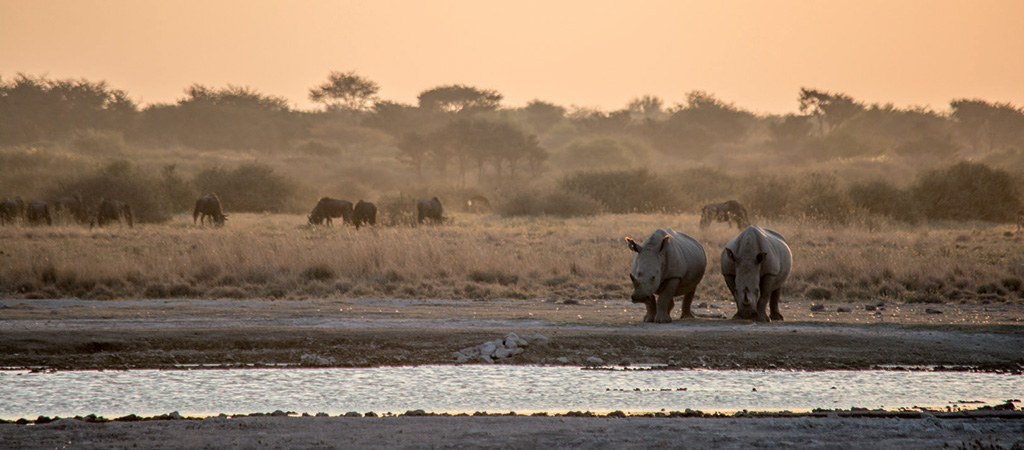
Rhino are a common sighting at Malema Pan.
Day 2 – 255km
Fill up at Letlhakane and head for the salt-pan network. Set up camp at Kubu Island and pack
a cooler box to take to the boulders for sundowners next to baobab trees. Get to bed early and wake up for sunrise too ‒ it’s a sight to behold. Pack water, firewood, loo paper
and any other supplies you need to be self-sufficient.
Park fees and camping costs about R225 per person per night.
Also read: Secret 4×4 route in Botswana: Kubu to Kukonje Island
Day 3 – 331km
Make sure you have Tracks4Africa to navigate the sand tracks across the salt pans to Gweta. Double back a few kays
and have lunch at Planet Baobab just off the A3. Sit back and enjoy a drink in the quirky bar as sarmies tend to take
a while. Drive the remaining 211km to Maun and camp at Audi Camp. It’s not beautiful, but it’s one of the better campsites just out of town. Camping costs about R88 per person, but there is no pre-booking these cheaper non-electrified sites. audisafaris.com
Day 4 – 156km
Wake up early and get to Maun Airport for an hour-long morning flight over the Okavango Delta with
Air Shakawe. Costs about
R1040 per person. Have brekkie at the nearby Wimpy and stock up on groceries and drinks at Choppies or Spar (both are
less than a kilometre away).
Buy some firewood (about R19 per bundle) from the hawkers lining the road up to Moremi and cross the buffalo fence into the wildlife area. You’ll need to pay park fees at South Gate (about R140 per person and R62 per vehicle per day) and drive roughly another two and half hours to reach the Third Bridge campsite on the outskirts of the Okavango Delta, overlooking the Moanachira River. Be sure to have printed proof of camping confirmations. SADC citizens pay about R338 per person per night. xomaesites.com
Day 5 – 36km
Get everybody up for an early-morning game drive along the fringes of the delta. You’ll need to cross Third Bridge, which is often underwater so get your game face on, pop the vehicle into low range and slowly ascend the log bridge. After brunch at the campsite, drive east to the Mboma Boat Station for a mokoro boat trip into the delta. Our one-hour trip turned into three hours, but the quoted rate is about R360 for an hour on a two-person boat.
Ask about bookings on arrival at South Gate and Third Bridge.
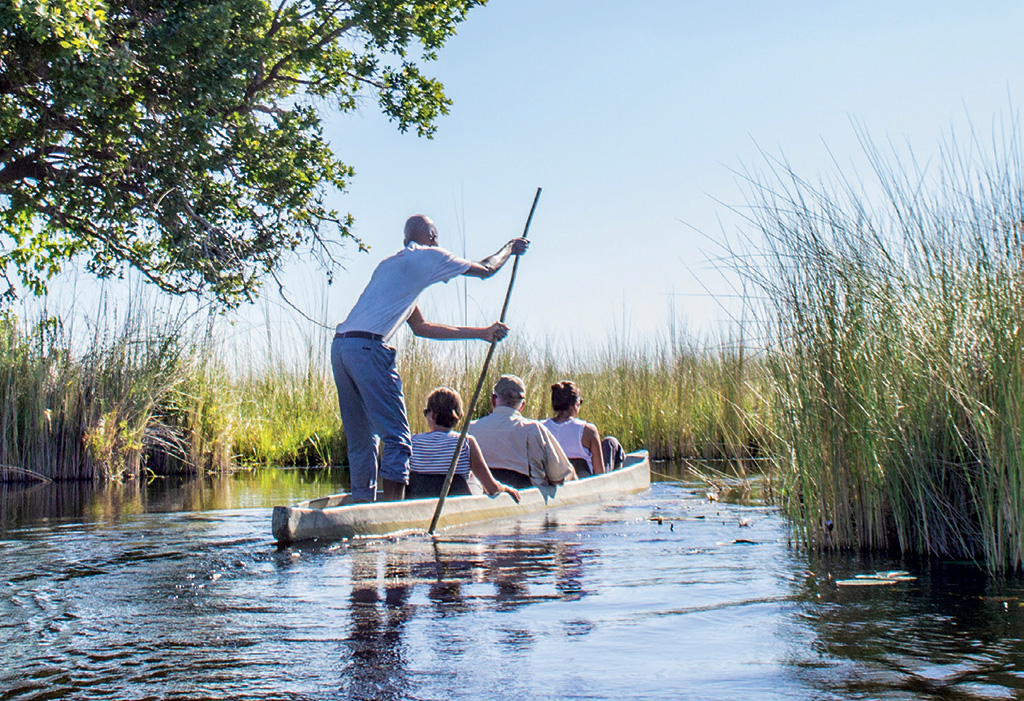
The Mokoro trips into the delta are a great way of getting to grips with the channels and spotting wildlife hiding in the papyrus.
Day 6 – 214km
Leave Third Bridge early
and exit Moremi at North Gate. Ask about the detour to avoid driving through the Khwai River. A new log bridge has been built in the nearby village ‒ Tracks4Africa will help again here. Enter Chobe National
Park and drive the long, sandy stretch to Savuti. Again, you’ll need to pay park fees at the gate and present proof of accommodation booking (about R150 pp and R62 per vehicle per day). Camping at Savuti costs R250 per person per night plus about R12 bed levy… and expect elephants. sklcamps.com
Day 7 – 155km
The road from Savuti is long
and sandy with severe corrugations. The tar at Kachikau is a relief for a few kilometres until you enter the Chobe National Park again. Seeing the Chobe River for the first time is magnificent and the campsites at Ihaha were easily the most picturesque of the trip. Park fees of about R150 per person and about R60 per vehicle per day apply and camping costs about R220 per person per night. It’s easiest to book through Umkulu Safari and Canoe Trails.
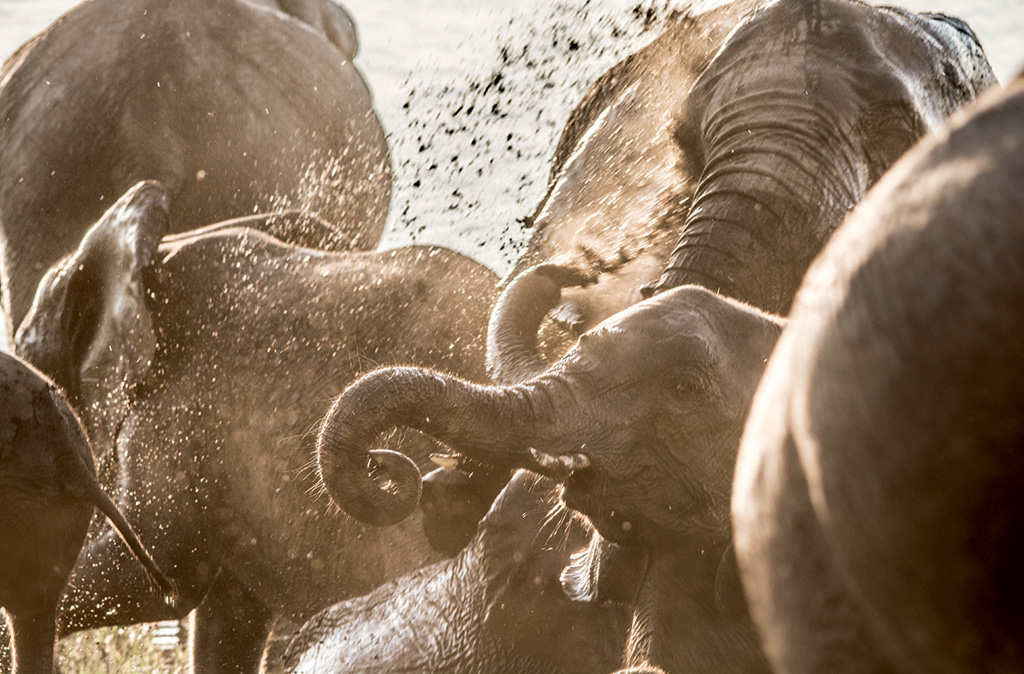
Elephants are a common sight in the Chobe National Park.
Day 8 – 39km
Take it easy and drive along the Chobe River, as you’ve only got to get to Chobe Safari Lodge roughly 40km away. Veto the afternoon booze cruise and book a private boat trip
at the activity centre for the following morning. It works out cheaper per person and the knowledgeable guide can manoeuvre the boat for a closer
look at game and birds. Then
while away the afternoon on the decks of the lodge and
upload those snaps using the
free WiFi. Camping costs
about R95 per person per night and
a two-hour boat trip costs
about R765 for up to six people. underonebotswanasky.com
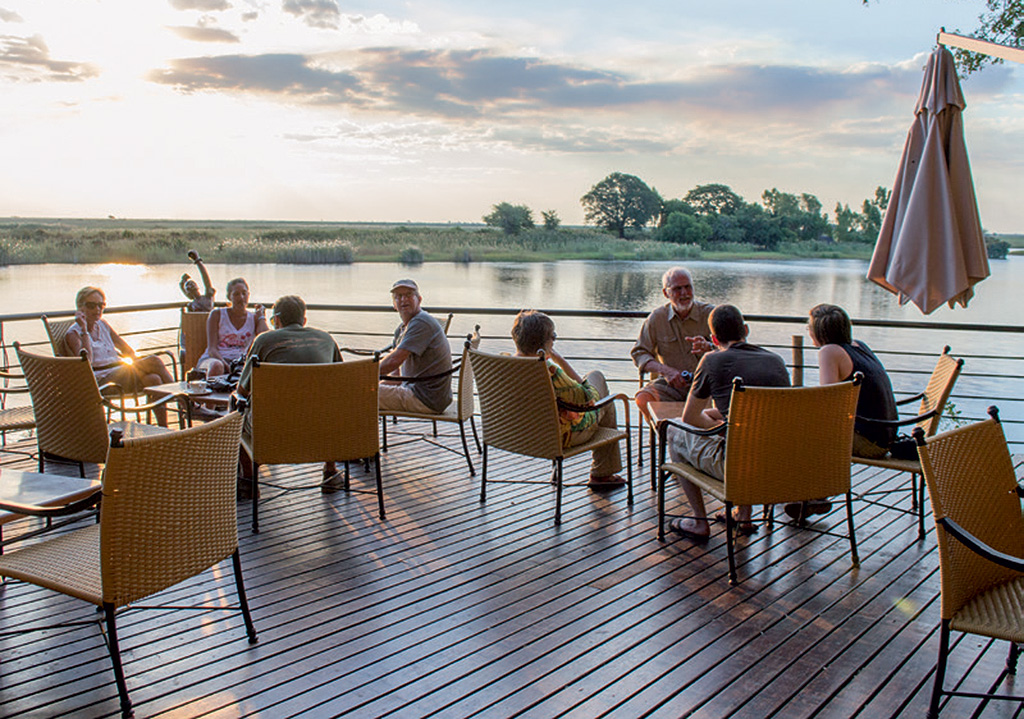
Sundowners on the deck at Chobe Safari Lodge.
Day 9 – 312km
Wake up at 07:00 and dress warmly for the scenic boat
trip on the Chobe River. Return to camp and pack up to leave for Nata Lodge near the Makgadikgadi salt pans.
Stay in a safari tent so you can take it easy on the last day of your trip, sleep on a thicker mattress and get an early start in the morning. Check with reception if there’s water on the pans and book a drive to see the flamingoes at the nearby Nata Bird Sanctuary.
A twin-bed Luxury Safari Tent costs about R965 per night and a three-hour drive to the
pans costs about R265 per person including one drink. underonebotswanasky.com
Day 10 – 873km
Leave Nata at about 06:00 and stop for a toasted sarmie at the Wimpy in Francistown. Head to the Martin’s Drift border post and drive home via Lephalale and the Waterberg again, turning onto the N1 for the
last 160km home.
Getting to Botswana
From Johannesburg take the
N1 north towards Pretoria
and turn off towards Modimolle, driving through the Waterberg via Lephalale to the Stockpoort border post. It was effortless and the smiles from officials on the Botswana side signalled we were in a different country. You need P140 (about R175) in cash to pay for vehicle road tax.
Botswana road trip costs
Pula is the official currency. At the time of going to print, P1 was equivalent to about R1,24. We travelled a total of 3000km with a fuel bill of roughly R4000 and the accommodation and activities for the trip cost about R4830 per person. In total, this holiday cost less than R9500 per person for 10 days, including food.
Need to know
South Africans don’t need
a visa. Leave dairy and meat at home because food regulations restrict imported supplies
and vehicle checks are made at various points in Botswana ‒ even in the middle of the salt pans. Some checks are more thorough than others, but we found most officials waved us through from their chairs.
While Moremi and Chobe
have ablutions, bring loo paper and stack up with enough firewood in Maun to last you
for four nights as there is none for sale in the parks.
Do not drive at night as warthog, cattle, goats and elephants roam the roads. Go during winter as many roads in summer become inaccessible due to mud, and water crossings are too high to safely navigate.
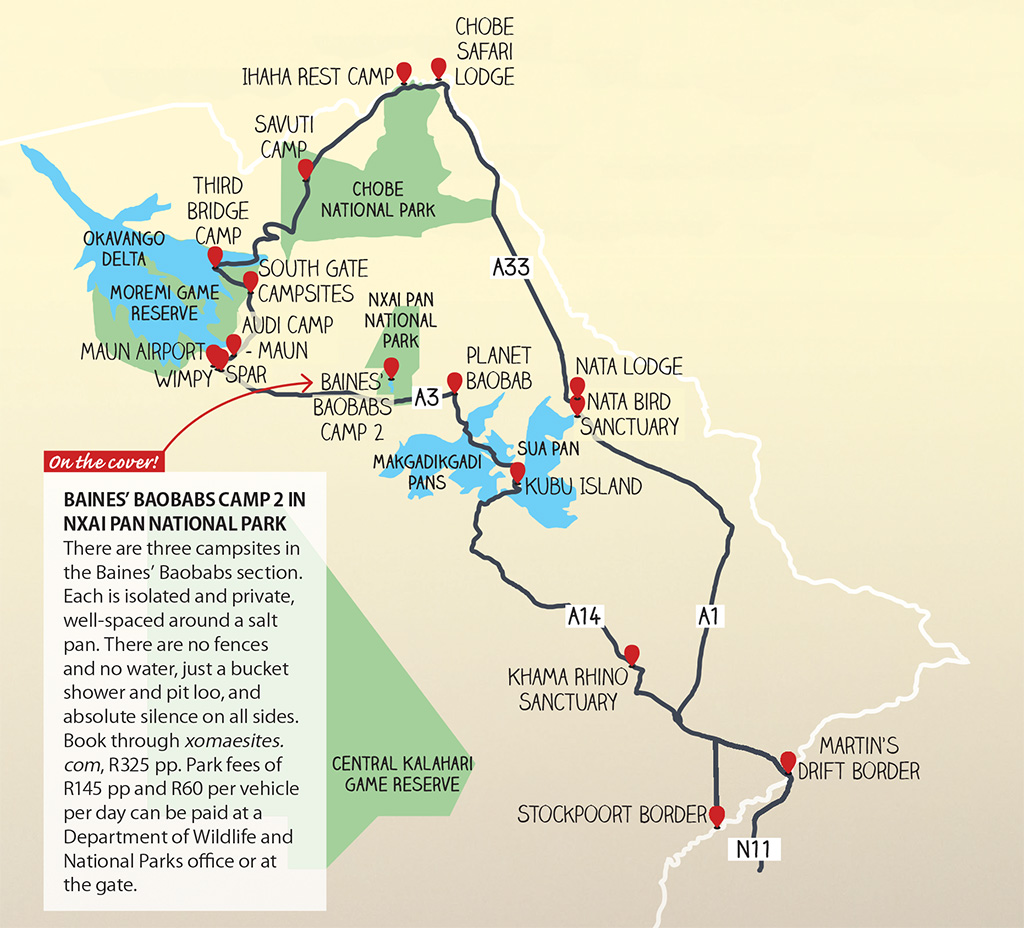
Also read: how to book campsites at Botswana’s national parks
This article first appeared in the August 2015 issue of Getaway magazine.
Get this issue →
All prices were correct at time of publication, but are subject to change at each establishment’s discretion. Please check with them before travelling.
You may also like
Related Posts
The Northern Cape landscape and its characters are full of life. Here are some of...
read more
This trip demands guts & grit. But for those who dare, what they give back...
read more
Knysna is blossoming again and its forests, estuaries and generous locals are ready as ever...
read more